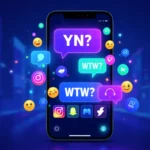If you’ve been scrolling through social media, reading corporate statements, or checking out job postings, you’ve probably noticed the term DEI everywhere. It’s modern, it’s relevant, and it’s one of the biggest topics shaping workplace culture and online conversations.
But what does it really mean?
Why do companies emphasize it?
Why do influencers, HR experts, and Gen-Z creators keep mentioning it?
This article breaks everything down in a simple, trendy, and totally human way—no jargon, no boring textbook definitions. Just real talk, real examples, and real insight.
Let’s get into it. 👇
Quick Answer
DEI stands for Diversity, Equity, and Inclusion—three principles used in workplaces, schools, and communities to create fair, respectful, and welcoming environments for everyone. (Keyword used once: 🚀what does dei stand for🚀)
What DEI Actually Means (In Simple Terms)
DEI is a framework that helps people understand how to build better environments—whether at work, in classrooms, or online communities. Each letter carries its own importance:
- Diversity = Who’s in the room?
A mix of backgrounds, identities, experiences, and perspectives. - Equity = Are the systems fair?
Making sure everyone has what they need to succeed—not assuming everyone starts from the same place. - Inclusion = Does everyone feel valued?
Ensuring people feel safe, respected, and free to show up as themselves.
Why DEI Became Such a Big Deal
DEI isn’t just a corporate buzzword anymore—it’s a cultural shift. Here’s why it blew up:
1. Social Awareness Is at an All-Time High
With global connectivity, people see and understand more diverse experiences than ever before. Gen Z has played a massive role in pushing for fair treatment and representation everywhere.
2. Workplaces Are More Global
Teams include people from different countries, religions, cultures, genders, orientations, and age groups. A more diverse team = better ideas, stronger creativity, and more innovation.
3. Customers Expect Brands to Be Responsible
People want companies that reflect their values. DEI-focused brands often see increased trust and loyalty.
4. It Reduces Conflict and Increases Performance
Studies show employees feel more engaged and productive when they feel respected and included.
Breaking Down DEI With Real-Life Examples
1. Diversity Examples
- A workplace with employees from different countries
- A classroom with a mix of cultures and languages
- A marketing team that includes people of multiple ages and perspectives
Simple rule: More viewpoints = stronger outcomes.
2. Equity Examples
Equity isn’t about treating everyone “the same.”
It’s about giving people what they specifically need.
- If a student has a disability, equity might be extra learning tools.
- If an employee struggles financially, equity might be access to support programs.
- If someone is new to tech, equity might be more training time.
Fair doesn’t always mean equal.
3. Inclusion Examples
Inclusion is about belonging.
- A meeting where everyone gets a chance to speak
- A workplace where people feel safe sharing their identity
- A team that listens to different opinions instead of ignoring them
Inclusion = “You’re part of this, and your voice matters.”
DEI in the Workplace: What It Looks Like Today
1. Inclusive Hiring Practices
This includes:
- Diverse interview panels
- Transparent job descriptions
- Encouraging applications from underrepresented groups
The goal: More fairness in who gets hired.
2. Training & Awareness Programs
Companies often provide:
- Bias training
- Cultural sensitivity workshops
- Leadership programs focusing on equitable decision-making
These build understanding and reduce unintentional discrimination.
3. Employee Resource Groups (ERGs)
ERGs create safe spaces for shared experiences, such as:
- Women in leadership groups
- Cultural heritage communities
- Groups for young professionals
- Neurodiversity support circles
They give employees community, voice, and representation.
4. Flexible Policies
DEI encourages policies like:
- Remote work options
- Mental health days
- Floating holidays for non-traditional celebrations
These allow people to be themselves without discomfort or conflict.
Why Gen-Z Especially Cares About DEI
Gen-Z is the most diverse generation in history—racially, culturally, and socially. They value authenticity, fairness, and representation.
Here’s why it matters to them:
- They want workplaces that reflect real-world diversity.
- They support brands that care about the community.
- They reject outdated systems and unfair structures.
- They choose inclusivity over division.
To Gen Z, DEI is not a trend—it’s a lifestyle.
How DEI Shows Up Online (Social Media Version)
Social platforms thrive on diversity and community, so DEI naturally fits in.
Examples:
- TikTok creators spreading awareness about marginalized voices
- Instagram pages promoting cultural education
- Influencers speaking about mental health and equal opportunities
- Content that highlights representation in movies, fashion, and gaming
The internet has amplified DEI conversations like never before.
Common Myths About DEI (And the Real Truth)
Myth 1: DEI is only for big companies
Reality: Small businesses, schools, and even online friend groups use DEI principles naturally.
Myth 2: DEI favors one group over another
Reality: It aims to create fairness and reduce barriers for everyone.
Myth 3: DEI is about numbers
Reality: Representation matters, but DEI focuses more on experiences, opportunities, and culture.
Myth 4: DEI is political
Reality: At its core, it’s simply about treating people fairly and respectfully.
How to Practice DEI in Everyday Life
Here are small ways to live out DEI principles daily:
- Listen more than you assume
- Respect differences even if you don’t understand them
- Invite quieter voices into the conversation
- Avoid stereotypes and generalizations
- Support diverse creators and businesses
- Be open to learning
You don’t need a job title or a role to care about fairness.
Examples of DEI Conversations in Real Scenarios
Scenario 1: School Group Project
A student who struggles with reading gets audio materials.
→ That’s equity.
Everyone’s opinions are respected during planning.
→ That’s inclusion.
The group includes students from different backgrounds.
→ That’s diversity.
Scenario 2: Workplace Brainstorming Session
The manager asks everyone for ideas, not just the outspoken team members.
→ Inclusion.
Scenario 3: Marketing Campaign
A brand uses a mix of ages, cultures, and body types in its ad.
→ Diversity.
Scenario 4: Tech Company Policies
Offering parental leave to all parents—not just mothers.
→ Equity and inclusion combined.
How DEI Impacts Business Success
Companies that embrace DEI often see major benefits:
- Better creativity and problem-solving
- Improved team morale
- Higher employee retention
- Increased customer trust
- Stronger brand loyalty
- More innovation
When people feel safe and valued, they produce their best work.
Challenges Organizations Face With DEI
While DEI is powerful, it’s not always simple. Some challenges include:
- Lack of awareness or education
- Resistance to change
- Poor communication
- Not enough resources
- Misunderstanding the purpose of DEI
The key is consistency, patience, and clear goals—not one-time workshops.
How to Measure DEI Progress
Organizations often track:
- Employee feedback surveys
- Retention rates
- Representation in leadership roles
- Participation in DEI programs
- Inclusivity scores
DEI isn’t a checkbox—it’s a long-term commitment.
The Future of DEI
DEI continues to evolve. The upcoming focus includes:
- Belonging: Making sure people feel connected
- Accessibility: Ensuring all spaces and tools are usable
- Psychological safety: Encouraging honest expression without fear
- Representation in digital spaces: Including AI and tech design
The conversation is growing—and shaping the next generation.
Conclusion
DEI isn’t just a trending term—it’s a meaningful reminder of how we can create better spaces for everyone.
From workplaces to classrooms, from social media to real life, these principles keep advancing our understanding of fairness, respect, and connection.
Whether you’re an employee, student, creator, or leader, embracing DEI helps you build stronger relationships and open-minded communities
. In a world that’s more interconnected than ever, choosing diversity, equity, and inclusion is choosing progress.











